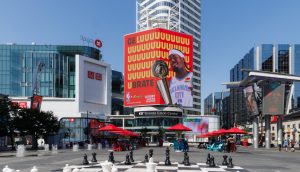The latest COMMB Insights report indicates positive gains in OOH activity and OTS (opportunities to see) across the board in June to July, with most provinces and metropolitan areas on a trajectory to approach or exceed 2019 pre-pandemic baseline.
Both Calgary and Edmonton have been leaders on the path back to 2019 norms, consistently indexing above 80% of the 2019 benchmark numbers since March. Growth in OOH activity has grown organically at a comparable pace. Unlike other regions, the province’s Stage 3 opening on July 1 is its final milestone. The pace could increase more rapidly in Alberta than the rest of the country with all restrictions removed.
Vancouver saw a modest index increase of two points (71% in July vs 69% in June), with posters and street furniture being the product groups contributing to this increase, while DOOH remained flat. British Columbia’s comeback is poised to rally as foreign tourism returns. During the booming baseline year of 2019, tourists spent 6.3 million nights in British Columbia, with the U.S. accounting for nearly four million overnight stays. After the travel industry ground to a halt early last year, it will take some time to return to 2019 levels.
Nearly all OOH sectors in Winnipeg have recovered to pre-pandemic levels, thanks to strong performance across the board in July. Overall numbers rose five points to 101%, led by double-digit gains in outdoor digital (89% to 100%). Superboards gained in July with an impressive double-digit improvement to reach 92% of 2019 levels. Posters and street furniture reached 103% and 100% respectively on gains of nine and eight points.
With about 64%of the Manitoba population inoculated, citizens may be more willing to venture out to movie theaters, casinos, restaurants, fitness facilities and public venues – most of which opened fully on July 17.
In Saskatchewan, Regina and Saskatoon have been neck-and-neck in the race to recovery throughout the reopening season with strong scores month after month. July was no exception, as Regina’s DOOH index gained six points while Saskatoon’s flat performance reached its third consecutive month. Saskatoon outperformed Regina 114% vs 113%. Saskatchewan entered Stage 3 on July 11, the province’s final level of reopening so this momentum is expected to continue.
Halifax, part of the Atlantic bubble, has been operating under different rules and regulations that allowed some travel within the bubble during the heart of the lockdown. It has maintained a strong index throughout much of the pandemic and has an index of 104% in July for DOOH.
The Ottawa-Gatineau metropolitan area shows that reopening protocols play a huge role in Canada’s recovery. The section located in Quebec soared 15 points and set the pace for the nation at 125 percent of the 2019 baseline. The Ontario section, which entered Stage 3 more than two weeks after Quebec, jumped seven points during the month and sits at 85% of baseline.
Toronto again saw a modest increase of five points, rising from 62% in June to 67% in July. With fitness facilities, stores, restaurants, and other indoor venues opening in mid-July, the full effect of loosened restrictions was not really felt during the month. DOOH performance, however, jumped six points to lead all OOH media formats reported. This gain could reflect the increase in highway traffic as workers begin their return to offices and families venture out for meals. The cancellation of many summertime events such as Canada Day celebrations likely dampened Toronto’s recovery.
Montreal inched up three points to 89%. This is a strong bounce back from its Q1 index of 71%. Quebec City shares a similar path and posted a 5-point gain bringing it close to 2019 norms with an index of 98%, up from 72% in Q1. Three of Quebec City’s major product groups indexed at least eight points higher than their June totals. Posters, which already indexed at 99%, eclipsed the 2019 benchmark by rising two points to 101%.
























